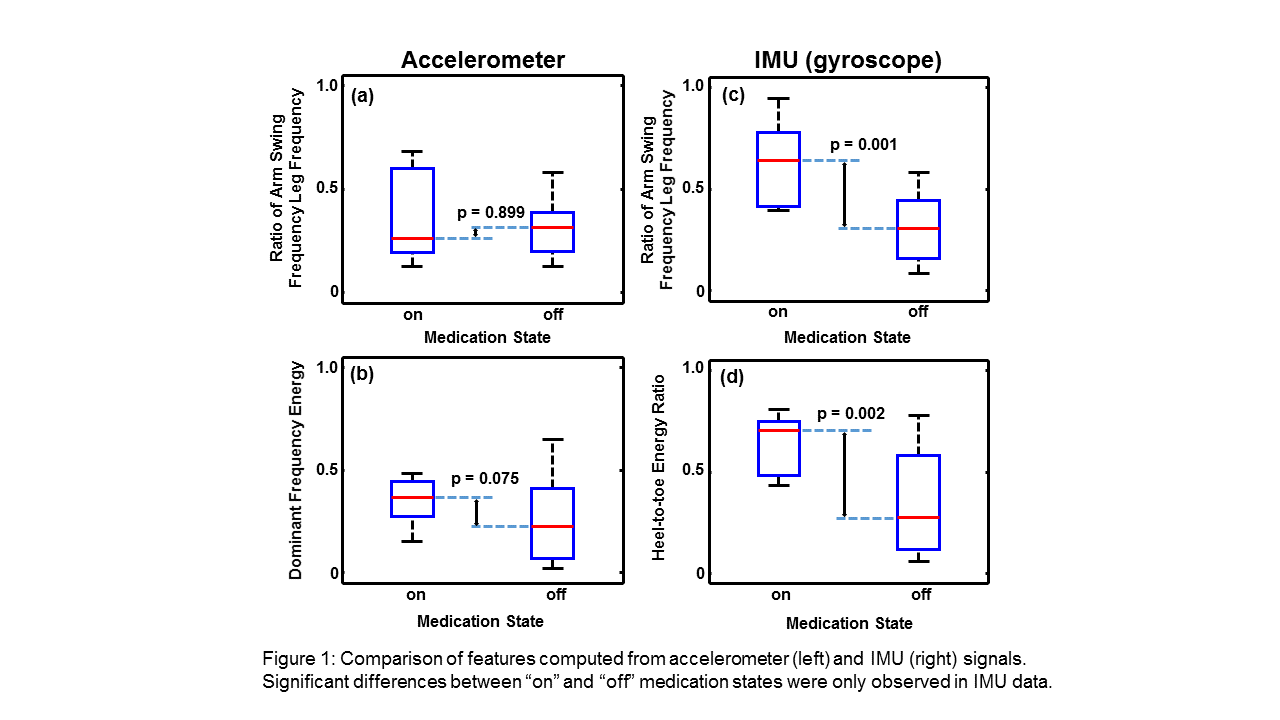Session Information
Date: Tuesday, June 6, 2017
Session Title: Technology
Session Time: 1:45pm-3:15pm
Location: Exhibit Hall C
Objective: To develop an automated system that uses a limited set of IMU sensors to improve the detection of gait abnormalities in Parkinson’s disease during unconstrained activities of daily living.
Background: The use of wearable sensors and automated algorithms for detecting and monitoring motor symptoms of Parkinson’s disease (PD) holds promise for improving medical assessments and treatments. However, present sensors based on accelerometers alone use energy-frequency metrics that do not capture some of the more subtle abnormalities in gait such as shuffling or reduced arm swing. To overcome this challenge, we developed an approach that uses IMU sensors to capture these gait abnormalities and compare them to accelerometer metrics during wearing off.
Methods: Sensors were placed on the upper- and lower-limbs of patients with mild to moderate PD (n=6; age: 60.8 ± 11 y; Hoehn & Yahr 1-3). Sensor and video recordings were acquired during 3-hour experiments of unconstrained activity in a simulated apartment setting. On-Off medication states and activity type (sitting, standing, and walking) were annotated from the video by movement disorder experts. Metrics derived from the sensor data during walking were compared for accelerometer and gyroscope data.
Results: Both accelerometer and gyroscope data could be used to measure the energy and dominant frequency of walking. However, the gyroscope data provided a greater ability to capture the degree of arm swing and shuffling of steps that could not be obtained from the accelerometer. When comparing these gyroscope features with the accelerometer features, we found that the gyroscope features showed significant difference between the On-Off transitions, while features from the accelerometer did not (Figure 1).
Conclusions: The use of IMU sensors to measure not only accelerometer but also gyroscope data provides an enhanced means for detecting gait abnormalities in PD during On-Off transitions. The improved ability of the gyroscope metrics to discriminate between these transitions and identify more characteristics of gait abnormalities in PD (such as shuffling and reduced arm swing), supports the preferred use of IMU over accelerometer sensors for automated body-worn gait analysis. These advantages may be of value in early detection of PD or as an outcome measure for medication titration.
To cite this abstract in AMA style:
B. Shiwani, S. Roy, J. Kline, M. Saint-Hilaire, C. Thomas, M. Gennert, G. De Luca. Improved Detection of Gait Abnormalities in Parkinson’s disease using an IMU Sensor-based System [abstract]. Mov Disord. 2017; 32 (suppl 2). https://www.mdsabstracts.org/abstract/improved-detection-of-gait-abnormalities-in-parkinsons-disease-using-an-imu-sensor-based-system/. Accessed November 7, 2025.« Back to 2017 International Congress
MDS Abstracts - https://www.mdsabstracts.org/abstract/improved-detection-of-gait-abnormalities-in-parkinsons-disease-using-an-imu-sensor-based-system/

